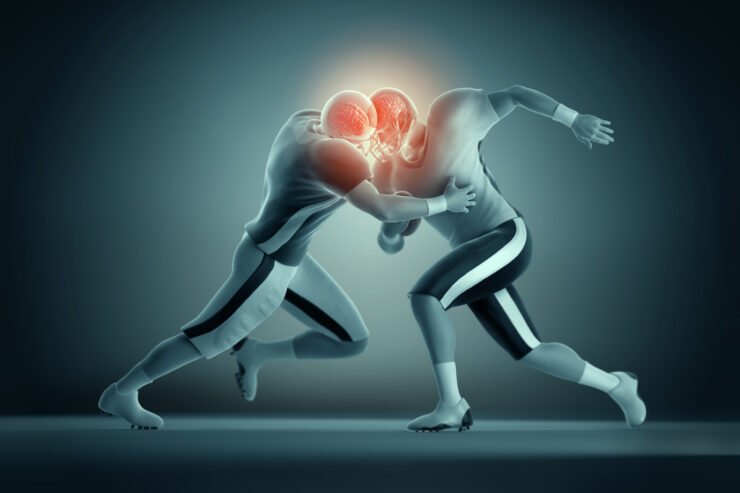Brain injuries are a serious concern for athletes participating in contact and collision sports. These injuries occur when the brain moves within the skull due to sudden impacts or forces. Such movements can lead to conditions such as cerebral concussion, cerebral contusion, or contrecoup injury, which can have long-lasting consequences. The severity of the injury depends on several factors, including the direction and strength of the impact, and the affected structures within the brain. It’s essential to recognize that brain injuries can result from a single blow or repeated blows that have a cumulative effect. As such, athletes must take steps to protect themselves during sports activities. In this article we will explore the different types of brain injuries, their causes, symptoms, and appropriate management measures.
What is a concussion?

A concussion is a type of mild traumatic brain injury that is frequently experienced by athletes during sports activities. The severity of a concussion can vary widely, ranging from a mild “bell-ringer” to a blow that results in loss of consciousness for more than five minutes. It’s important that coaches, trainers, therapists, and physicians who cover athletic contests understand the various types of concussions and appropriate treatment measures. Inappropriate care can have serious and sometimes lifelong consequences. In Canada, approximately 200,000 concussions occur each year, with significant and long-lasting cognitive impairments often resulting from these injuries. Information processing speed, problem-solving, planning, and memory are just a few examples of cognitive functions that can be impacted, and these impairments can become worse with repeated concussions.
Treatment of a Concussion
To manage a concussion, a thorough review of the athlete’s injury history, neurological screening, and cervical vertebrae and musculature inspection and palpation are necessary. Several scales are used to grade concussions, with the Glasgow Coma Scale being the most commonly used. This scale evaluates eye opening, motor responses, and verbal responses and assigns a numerical value to each. The American College of Surgeons Committee on Trauma has adopted the alert/verbal/painful/unresponsive (AVPU) method for determining levels of consciousness. It involves assessing an athlete’s response to verbal or painful stimuli and pupil size and reaction. Careful evaluation of pupil size and response to light is crucial as raised intracranial pressure can cause pupillary dilation and sluggish response.
At a known physiotherapy clinic in Whitby, experts use the complete concussion management protocol, which involves taking a baseline test of our athletes. This test provides our therapists with important information regarding an athlete’s brain function when it is healthy. In the event of a concussion, this baseline data helps identify any remaining deficits and gauge brain recovery levels, allowing for safer decisions regarding return to sports activities.
Classification of Concussions

While there are numerous concussion grading systems and return-to-play guidelines documented in the medical literature, only three have been widely accepted: Grade 1 (mild), Grade 2 (moderate), and Grade 3 (severe). Despite the lack of universal agreement on the definition and grading of concussions, all medical professionals agree that athletes who are experiencing post-concussion signs or symptoms, whether at rest or with exertion, should not return to contact or collision sports. Recognizing the significance of past concussions and the possibility that many athletes may not have recognized all their past concussions, it is essential to have a detailed concussion history.
Signs and Symptoms of concussion
A player may suffer from a concussion without losing consciousness. If any of the following symptoms or issues arise, a head injury should be suspected, and the appropriate management should be implemented:
- Cognitive features: confusion; amnesia; unawareness of time, date, place, period, opposition, or game score; loss of consciousness.
- Typical symptoms: dizziness; headache; unsteadiness or loss of balance; feeling dazed, stunned, or “dinged”; seeing stars or flashing lights; ringing in the ears; double vision; nausea.
- Physical signs: impaired conscious state or loss of consciousness; poor coordination or balance; impact seizure or concussive convulsion; loss of balance or gait unsteadiness; slow to follow directions or answer questions; easily distracted or poor concentration; inappropriate emotions such as laughing or crying; vomiting; glassy-eyed or vacant stare; slurred speech; personality changes; inappropriate playing behavior, such as running in the wrong direction; and significantly reduced playing ability.
Other symptoms such as sleepiness, sleep disturbance, or a subjective feeling of slowness and fatigue may also occur.
Final thoughts

It is important to recognize the seriousness of brain injuries and their potential long-term effects. Athletes and coaches should prioritize preventative measures, such as wearing appropriate protective gear, using proper techniques, and avoiding contact or collisions that could result in head trauma. Additionally, education and awareness campaigns aimed at athletes, coaches, parents, and healthcare professionals can help reduce the incidence of brain injuries and promote proper management when they do occur. While much remains to be learned about brain injuries, continued research and advocacy can help ensure that athletes are better protected and supported in their pursuit of athletic excellence.

